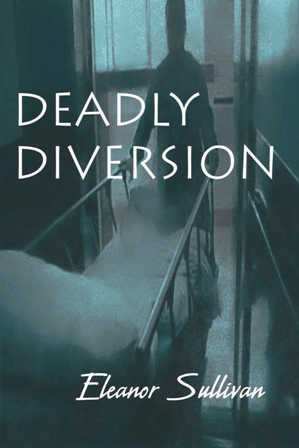Library
WHODUNIT/MEDICAL/CLASSIC/
AMATEUR SLEUTH MYSTERY
AMATEUR SLEUTH MYSTERY
DEADLY DIVERSION
Wednesday, 08 August, 0645 Hours
“Guardino’s gone.” Bart said, giving me a quick glance.
“Gone? Where?”
“Dead,” Bart replied, continuing to write in the chart in front of him.
I sat down hard, rattling the chair back. “What happened?”
Bart shrugged. An experienced critical care nurse, Bart had moved to St. Louis to study anesthesia in graduate school and had started work at St. Teresa’s Hospital six months ago. He’d wanted to work nights so he could go to school during the day. Few nurses wanted the night shift so I was glad to give it to him.
“Where’s his chart?”
“Why?” Bart asked, turning to face me.
“I want to know what happened.”
“As soon as I finish.” Bart shifted his attention back to the chart.
“Where’s the body?” I asked, looking around for a gurney from the morgue.
“I sent it on down,” he said, writing as he spoke. “I wanted to get it out of here before everyone arrived.”
“So what happened?”
“Here. See for yourself.” He closed up the chart and tossed it onto the counter in front of me. It landed with a clatter.
“The chart’s supposed to go with him,” I said, opening it up.
I had started out at St. Teresa’s straight out of nursing school more than twenty years earlier, working on medical-surgical floors until I’d been able to get my clinical legs under me, then I’d transferred to intensive care where the rush of adrenaline fed my need for excitement. Head nurse—now called patient care manager—for the last five years, I found the job becoming more and more difficult as managed care squeezed ever-increasing dollars out of our budget, and the nursing shortage meant each shift was a gamble.
“I’ll take it down when I leave.” Bart stretched his arms above his head, muscles rippling under his green scrub suit top. He closed the fat textbook that lay on the counter and stacked a yellow legal pad covered with notes on top of it.
“No surprise, I guess,” I said.
Mr. Guardino had come in three days before, unconscious from a stroke. Since he’d arrived his body had been shutting down, one organ system after another, in spite of our best efforts to keep him alive.
“My god!”
“What?” Bart asked, wadding up some scraps of paper. He tossed them toward the trash can under the counter. They fell short.
“You didn’t intubate him? Or shock him?”
“He was a B code, wasn’t he?” Bart asked, referring to the A, B, C system of coding we’d recently adopted to designate what should be done in case of a cardiac or respiratory arrest.
“No! The family was emphatic—full resuscitation. He was an A.”
An A code required that everything medically possible be done to resuscitate the patient. B codes, generally used for patients unlikely to survive, specified limited resuscitation efforts; and with a C code, previously designated as a “do not resuscitate” order, no resuscitation would be attempted.
“It wouldn’t have helped anyway,” Bart said. “He couldn’t have been resuscitated, no matter what the code was.”
Determination of the appropriate code was based on the patient’s condition and likelihood of recovery as well as his or her previously-stated wishes and the family’s desires at the time. It wasn’t a perfect system, by any means. Such life-and-death decisions are difficult even if they are discussed ahead of time, but under the stress of a critical illness families and staff alike find themselves torn between wanting to keep the person alive and accepting the futility of trying. And seldom do all those involved agree.
I wiped my hand across my face. “You didn’t know that. I’ve seen them come back from. . . . Anyway, it was your job to know which code to use and to follow it.”
“Do you know how much care he required?” Bart asked, going on without waiting for my reply. “The constant juggling act it took to keep all those drips going? Keep his pressure up, they say, we’ve got to save what viable brain he has, they say, but not too high, they say, or he might stroke out.” He flung his arms outward and heaved a sigh.
“I know all that—”
“You don’t know the half of it, Monika. Do you know how many meds he was on? Antibiotics, muscle relaxants, a beta blocker—that was for the heart damage from the defibrillator they used in the ER to restart his heart—and more.” He rubbed the stubble on his chin. “And me here in charge alone on nights. It’s all we can do to keep up with the ones who are recovering. as understaffed as we are.” Bart stood and reached for his lab coat draped across the counter. “I did the best I could. No one can ask for more than that.” He swung the lab coat over his shoulder and started toward the door.
“I’ve got to write you up for this.” I reached for the incident report forms in the drawer.
He turned toward me, and I caught a flicker of anger. Just as quickly it was gone.
I stared at the form. Damn. This was the last thing I wanted to do—write up a competent nurse of whom I had far too few.
“Listen,” he said, coming back. “Are you really going to screw things up for me over some old man who was dying anyway?”
“Policy, Bart. And the law. It’s not your decision.” I looked back down at the form in front of me.
He dropped his book on the counter and leaned over me on the desk, fingers splayed. Wisps of blond hair curled on the backs of his hands. “I need this paycheck ’til I finish grad school,” he said, “and you’re not going to mess me up!”
Two nurses on the day shift came through the door.
“You keep quiet,” Bart said, then he picked up his book and papers and left the unit.
“Guardino’s gone.” Bart said, giving me a quick glance.
“Gone? Where?”
“Dead,” Bart replied, continuing to write in the chart in front of him.
I sat down hard, rattling the chair back. “What happened?”
Bart shrugged. An experienced critical care nurse, Bart had moved to St. Louis to study anesthesia in graduate school and had started work at St. Teresa’s Hospital six months ago. He’d wanted to work nights so he could go to school during the day. Few nurses wanted the night shift so I was glad to give it to him.
“Where’s his chart?”
“Why?” Bart asked, turning to face me.
“I want to know what happened.”
“As soon as I finish.” Bart shifted his attention back to the chart.
“Where’s the body?” I asked, looking around for a gurney from the morgue.
“I sent it on down,” he said, writing as he spoke. “I wanted to get it out of here before everyone arrived.”
“So what happened?”
“Here. See for yourself.” He closed up the chart and tossed it onto the counter in front of me. It landed with a clatter.
“The chart’s supposed to go with him,” I said, opening it up.
I had started out at St. Teresa’s straight out of nursing school more than twenty years earlier, working on medical-surgical floors until I’d been able to get my clinical legs under me, then I’d transferred to intensive care where the rush of adrenaline fed my need for excitement. Head nurse—now called patient care manager—for the last five years, I found the job becoming more and more difficult as managed care squeezed ever-increasing dollars out of our budget, and the nursing shortage meant each shift was a gamble.
“I’ll take it down when I leave.” Bart stretched his arms above his head, muscles rippling under his green scrub suit top. He closed the fat textbook that lay on the counter and stacked a yellow legal pad covered with notes on top of it.
“No surprise, I guess,” I said.
Mr. Guardino had come in three days before, unconscious from a stroke. Since he’d arrived his body had been shutting down, one organ system after another, in spite of our best efforts to keep him alive.
“My god!”
“What?” Bart asked, wadding up some scraps of paper. He tossed them toward the trash can under the counter. They fell short.
“You didn’t intubate him? Or shock him?”
“He was a B code, wasn’t he?” Bart asked, referring to the A, B, C system of coding we’d recently adopted to designate what should be done in case of a cardiac or respiratory arrest.
“No! The family was emphatic—full resuscitation. He was an A.”
An A code required that everything medically possible be done to resuscitate the patient. B codes, generally used for patients unlikely to survive, specified limited resuscitation efforts; and with a C code, previously designated as a “do not resuscitate” order, no resuscitation would be attempted.
“It wouldn’t have helped anyway,” Bart said. “He couldn’t have been resuscitated, no matter what the code was.”
Determination of the appropriate code was based on the patient’s condition and likelihood of recovery as well as his or her previously-stated wishes and the family’s desires at the time. It wasn’t a perfect system, by any means. Such life-and-death decisions are difficult even if they are discussed ahead of time, but under the stress of a critical illness families and staff alike find themselves torn between wanting to keep the person alive and accepting the futility of trying. And seldom do all those involved agree.
I wiped my hand across my face. “You didn’t know that. I’ve seen them come back from. . . . Anyway, it was your job to know which code to use and to follow it.”
“Do you know how much care he required?” Bart asked, going on without waiting for my reply. “The constant juggling act it took to keep all those drips going? Keep his pressure up, they say, we’ve got to save what viable brain he has, they say, but not too high, they say, or he might stroke out.” He flung his arms outward and heaved a sigh.
“I know all that—”
“You don’t know the half of it, Monika. Do you know how many meds he was on? Antibiotics, muscle relaxants, a beta blocker—that was for the heart damage from the defibrillator they used in the ER to restart his heart—and more.” He rubbed the stubble on his chin. “And me here in charge alone on nights. It’s all we can do to keep up with the ones who are recovering. as understaffed as we are.” Bart stood and reached for his lab coat draped across the counter. “I did the best I could. No one can ask for more than that.” He swung the lab coat over his shoulder and started toward the door.
“I’ve got to write you up for this.” I reached for the incident report forms in the drawer.
He turned toward me, and I caught a flicker of anger. Just as quickly it was gone.
I stared at the form. Damn. This was the last thing I wanted to do—write up a competent nurse of whom I had far too few.
“Listen,” he said, coming back. “Are you really going to screw things up for me over some old man who was dying anyway?”
“Policy, Bart. And the law. It’s not your decision.” I looked back down at the form in front of me.
He dropped his book on the counter and leaned over me on the desk, fingers splayed. Wisps of blond hair curled on the backs of his hands. “I need this paycheck ’til I finish grad school,” he said, “and you’re not going to mess me up!”
Two nurses on the day shift came through the door.
“You keep quiet,” Bart said, then he picked up his book and papers and left the unit.

